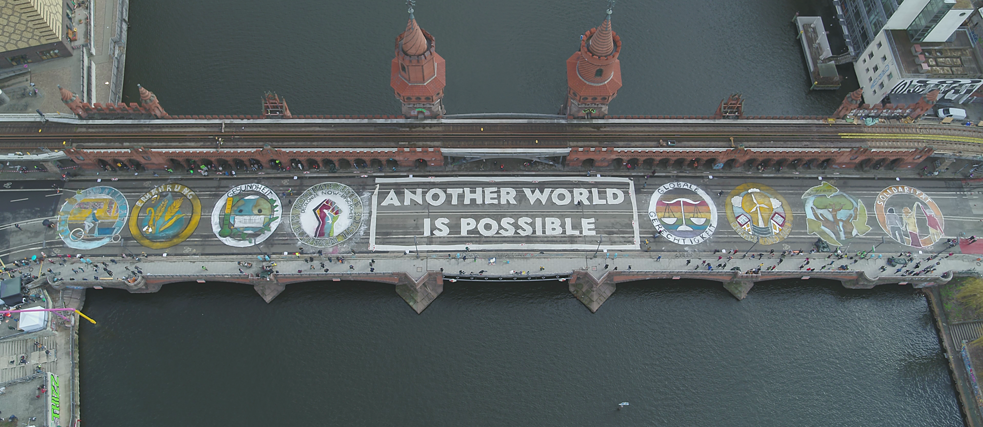Goals of the Climate Justice Movement
Strength in Plurality

Activists painted Hopeful: “Another world is possible” in huge letters and pictures on the Oberbaum Bridge in Berlin.
|
© Fridays For Future Berlin
What does the climate justice movement want? Many groups in the movement seem to have different goals. But is this even the case? Aren’t all the perspectives connected?
By Asuka Kähler
What was climate justice again?
Unlike climate protection or environmental protection, climate justice does not see the climate crisis as primarily an ecological crisis, but rather as the result of our way of doing business, the creation thereof and the injustices and power relations associated therewith, i.e. as a complex question of social justice. For us activists, it is not merely a matter of meeting climate targets, but also about how we go about it.But doesn't everyone in the movement have the same goals and approaches?
Climate justice consequently means reflecting on the links between, e.g. racism, our capitalist economic system, classism, the climate crisis and many other problems. This can be extensive, complex and therefore sometimes difficult to understand. As a result, some groups in the climate justice movement have different focuses - some for individual projects or campaigns, others in general - because it is hardly possible to consider all the connections at the same time.Where are the differences?
Let us look at the Black Earth Collective and Fridays for Future Germany by way of example of differences in content. The Black Earth Collective deals with climate justice from a decolonial and intersectional perspective and strongly addresses the historical emergence and interconnectedness of these issues - a perspective that has gained relevance in Fridays For Future Germany since its emergence, but is not dominant in terms of its external impact. Instead, many projects are geared to current political developments, decisions and events. Explicit perspectives on climate justice are rarely defined. The lack of a historical and therefore anti-colonial perspective on the climate crisis can be criticised in the German offshoot of Fridays For Future - yet the differences in orientation are significant. There are some other differences between these and various other groups - not only in terms of content, but also in the forms of action or composition of personnel, for example.Why are different orientations important?
The different priorities enable the respective groups to focus more on the areas in which they bring expertise to bear and to work specifically on those issues. And yet, each group should engage with the different approaches and perspectives. For instance, white-dominated groups in particular need to familiarise themselves with anti-racist perspectives - something that has often been neglected in the past. The groupings of the movement need to stand together in active exchange, mutual solidarity and support. Ideally, they should coordinate their actions so as to benefit from each other, making the climate movement stronger as a whole. This approach can ensure that the different perspectives are adequately represented.The differences between different groups and as well as within individuals are not a sign of weakness. There should be no attempt to deny the legitimacy of a position in the climate justice movement - as long as it is within the framework of climate justice.
Next week, Victoria Berni will show how the different attitudes and backgrounds of people can be in the groupings. We as activists need to learn to draw strength from this plurality by complementing - rather than trying to outdo - each other in any way. Otherwise we will not be successful as a movement in the long run.